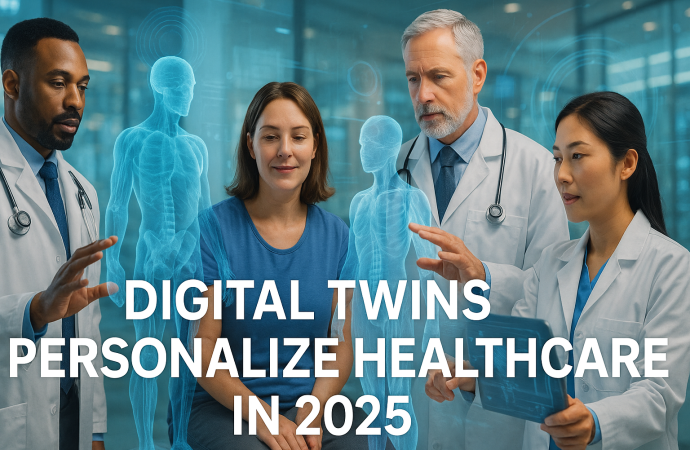Introduction Healthcare is changing fast. In 2025, doctors use digital twins healthcare technology to tailor treatments. A digital twin is a virtual copy of a patient. It uses real data from sensors, scans, and medical records. This copy helps doctors see how a body might react to treatments before trying them on a person. Imagine
Introduction
Healthcare is changing fast. In 2025, doctors use digital twins healthcare technology to tailor treatments. A digital twin is a virtual copy of a patient. It uses real data from sensors, scans, and medical records. This copy helps doctors see how a body might react to treatments before trying them on a person.
Imagine a virtual model of your heart. Doctors test different medicines on it. They see which option works best. This process makes care safer. It also saves time and cuts costs. In this article, you will learn what virtual patient models are. You will see how they boost personalized healthcare. You will also find tips on supporting AI tools for better care in 2025.
What Are Digital Twins?
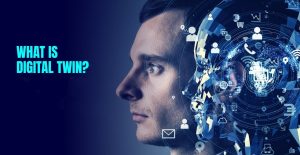
Image by: Yandex.com
A digital twin is a computer model that mirrors a real object or system. In healthcare, the object is a patient’s body or organ. To build a twin, experts collect data from tests, scans, sensors, and medical records. They feed this data into AI and simulation software.
The model then simulates how the body works now and how it might change in the future. For example, a digital twin of a patient’s lungs can help doctors track breathing patterns. They can see how a new medicine might affect the lungs. This method uses real-time patient monitoring to keep the twin updated as the real patient’s condition changes.
Digital twins are not new to industries like manufacturing process or aviation. Those sectors use them to predict machine failures and test designs. In healthcare, the idea is similar. You test virtual treatments on the twin before treating the real person. This reduces risks and helps doctors make better informed decisions.
How Digital Twins Personalize Healthcare

Image by: Yandex.com
Digital twins enable truly personalized healthcare. They use patient-specific data to build a model that matches age, weight, genetics, and lifestyle. Because of this, doctors can:
- Predict how a patient will respond to certain drugs.
- Test different treatment plans without risk.
- Monitor disease progression in detail.
- Create virtual trials to see long-term effects.
For instance, a digital twin of a patient with diabetes can simulate blood sugar changes. Doctors can adjust insulin doses in the virtual model first. This prevents dangerous blood sugar swings in real life. It also saves the patient from trying many dose changes that might not work.
Similarly, for cancer care, doctors use a twin of a tumor to plan radiation therapy. The twin helps them identify which dose hits only the cancer cells. This spares healthy tissue and reduces side effects. Such patient-specific simulations revolutionize treatment precision.
Digital twins also help with preventive care. By feeding data like activity levels, diet, and sleep patterns into the model, doctors can predict future health risks. They can then advise lifestyle changes or start early treatments. This proactive approach can keep patients healthier longer.
Benefits of Digital Twins in Healthcare
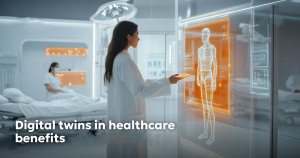
Image by: Yandex.com
The use of digital twins healthcare offers many advantages:
- First, doctors get deeper valuable insights into each patient. They see how diseases evolve. They know how a patient’s unique traits affect treatment.
- Second, treatment risks drop. Virtual tests on a twin avoid trial-and-error on the real person. This approach reduces side effects and complications.
- Third, cost savings are significant. Hospitals spend less on ineffective tests and admissions. Patients spend less on wasted treatments.
- Fourth, clinical trials become faster and cheaper. Researchers use digital twins to screen candidates and predict drug effects. This cuts the time needed to test new medicines in large groups.
- Fifth, patient engagement improves. When patients see their own twin’s data, they understand health issues better. They follow care plans more closely because they see real-time results in their virtual model.
- Finally, predictive health analytics help with early diagnosis. Digital twins spot small changes that might signal trouble. Doctors can step in before problems become severe.
Technology Behind Digital Twins
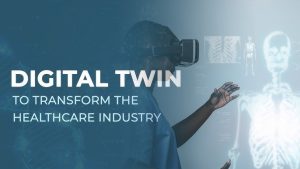
Image by: Yandex.com
Digital twins rely on several technologies:
- AI and Machine Learning: These tools process large data sets. They learn patterns from real patients. Then they apply those patterns to build accurate virtual models.
- Cloud Computing: Twins run on powerful cloud servers. This setup lets doctors access models from anywhere. It also scales computing power when needed.
- Internet of Things (IoT) Sensors: Wearable devices and smart sensor data collect real-time data on heart rate, blood pressure, blood sugar, and more.
- Big Data Analytics: These systems handle vast amounts of health data. They provide insights about population trends and individual cases.
- 3D Modeling and Simulation Software: These tools create visual, dynamic models of organs and tissues. Doctors can see simulations in 3D to understand complex systems.
Together, these technologies power AI-driven care that adapts to each patient’s needs.
Use Cases for Digital Twins in 2025
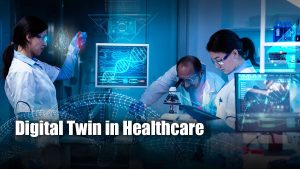
Image by: Yandex.com
By 2025, digital twins will be common in many areas of medicine. Here are key use cases:
1. Cardiology
In heart care, doctors create a digital twin of a patient’s heart. They use data from MRI scans, ECGs, and wearable monitors. The twin simulates blood flow, valve function, and electrical signals. Doctors can test how a stent or surgery plan will work before doing the actual procedure. This method reduces the chance of complications.
2. Oncology
Cancer treatment benefits from tumor twins. Oncologists build a model of a patient’s tumor, using biopsy data and imaging scans. They test radiation doses and chemo drugs on the twin. This helps find the best dose that kills cancer cells but spares healthy cells. It leads to more precise, less toxic treatments.
3. Management
For people with diabetes, a digital twin tracks blood sugar, diet, and activity. The model predicts how sugar levels change with meals and exercise. Doctors and patients can adjust insulin doses in the twin to find the optimal plan. This reduces dangerous highs and lows and helps patients stay healthier.
4. Orthopedics
In joint and bone care, a twin of a knee or hip guides surgeons. Using CT or MRI data, they build a virtual joint. The twin shows how implants will fit and function. This allows surgeons to plan exact cuts and placements. It leads to faster recovery and fewer revisions.
5. Preventive Medicine
Digital twins also work for healthy people who want to stay well. By feeding data like diet, activity, and sleep into a twin, doctors can spot lifestyle risks early. They give personalized health advice to prevent heart disease, obesity, or hypertension. This proactive model promotes wellness and reduces healthcare costs.
Tips for Healthcare Providers
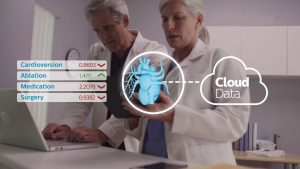
Image by: Yandex.com
For hospitals and clinics planning to use digital twins, consider these tips:
- Start with a Pilot Project: Choose one use case, like heart surgery planning. Run a small pilot to test technology and workflows. Learn from the pilot before scaling up.
- Invest in Secure Data Infrastructure: Use strong encryption and secure cloud services. Follow regulatory standards like HIPAA or GDPR to protect patient data.
- Train Clinicians Early: Offer workshops and hands-on training for doctors, nurses, and technicians. The more comfortable staff is with twins, the better the adoption.
- Partner with Tech Providers: Work with established companies that specialize in predictive health analytics. They bring expertise and proven platforms.
- Collect Continuous Feedback: Ask doctors and patients for feedback. Update models and workflows based on real-world experiences. Continuous improvement is key.
- Monitor Outcomes: Track patient outcomes, costs, and satisfaction. Compare results with traditional methods to measure twin technology’s impact.
- Plan for Scaling: Prepare infrastructure to handle more models and data as the program grows. Use cloud services that can expand easily.
Implementing twins in a step-by-step way helps avoid costly mistakes and maximizes benefits.
Challenges and Considerations
Despite its promise, digital twins healthcare faces challenges:
- Data Privacy: Managing sensitive health data is critical. Hospitals must secure data and follow privacy rules. Patients should control who sees their data.
- Data Quality: Twins need accurate data from sensors and records. Incomplete or wrong data leads to faulty models. Medical staff must ensure data is correct and up to date.
- Integration with Workflows: Hospitals must integrate twin systems with existing workflows. Doctors need training to use twin technology effectively.
- Cost of Implementation: Creating and maintaining twins can be expensive. Small clinics may struggle to afford the technology. Health systems need to weigh costs and long-term savings.
- Ethical Concerns: Using twins to choose treatments raises questions. If a twin model suggests one patient needs therapy A and another needs therapy B, how do we ensure fairness? Clear guidelines are needed.
- Technical Limitations: Models may not capture every nuance of a real body. Rare diseases or complex conditions can be hard to simulate. Continuous improvement and validation are essential.
By addressing these issues, healthcare providers can safely deploy patient-specific simulations for better outcomes.
Future Outlook for Digital Twins in Healthcare
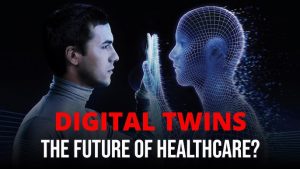
Image by: Yandex.com
By 2030, digital twins healthcare may be as common as X-rays. Advances in AI and sensor technology will make twin creation faster and more accurate. Wearable devices will feed data continuously, ensuring up-to-date twins.
Universal health records will integrate with twin systems. When someone visits a clinic, their twin will already exist and update in real time. This continuous model gives doctors a full view of a patient’s health journey.
Personalized medicine will thrive. Genetic data, lifestyle data, and environmental factors will feed into twins. Patients will get treatment plans tailored to their unique makeup. Drugs and therapies will be tested virtually, reducing cost trial-and-error.
Telemedicine will blend with digital twin technology. Doctors will consult patients via video and use twins to show simulations. Patients will see their twin’s response to treatment in real time. This virtual collaboration brings expert care to remote areas.
Overall, sky-high costs and trial-and-error treatments will drop. As twins become more reliable, insurance companies may cover virtual trials to reduce long-term costs. Global health equity could improve, as small clinics in low-resource areas use cloud-based twin platforms to access top-tier simulations.
Comparative Table: Digital Twins vs. Traditional Methods
| Aspect | Traditional Methods | Digital Twins |
|---|---|---|
| Diagnosis | Based on static tests and doctor’s view | based on real-time data and simulations |
| Treatment Planning | One-size-fits-all guidelines | patient-specific simulations |
| Risk of Complications | Higher due to trial-and-error approach | Lower due to virtual testing |
| Cost | High due to repeated tests and hospital stays | Lower through targeted, efficient care |
| Time to Treatment | Weeks to schedule tests and surgeries | Faster; simulations guide decisions quickly |
| Patient Engagement | Limited understanding of treatment impact | Twin’s real-time feedback boosts adherence |
| Predictive Capabilities | Reactive, based on past trends | proactive, predicts future risks |
| Personalization Level | Generalized, based on population data | Highly personalized, using individual data |
Conclusion
Digital twins transform healthcare by making it truly personalized. They use real-time data, AI, and simulations to create virtual patient models that mirror real bodies. This approach cuts risks, lowers costs, and speeds up treatment decisions. In 2025, doctors can plan surgery on a twin, test drugs in a virtual model, and predict disease progression before it happens.
Despite challenges like data privacy and cost, the benefits are clear. Twins help doctors choose the best treatment for each person. They also empower patients by showing how their choices affect health in real time. Early pilots in cardiology, oncology, and diabetes care have proven twin technology’s potential to save lives and money.
As the technology matures, twins will become easier to create and maintain. Integration with wearables and universal health records will keep models fresh and accurate. By 2030, digital replica twins may guide most clinical decisions, turning reactive care into proactive health management.

